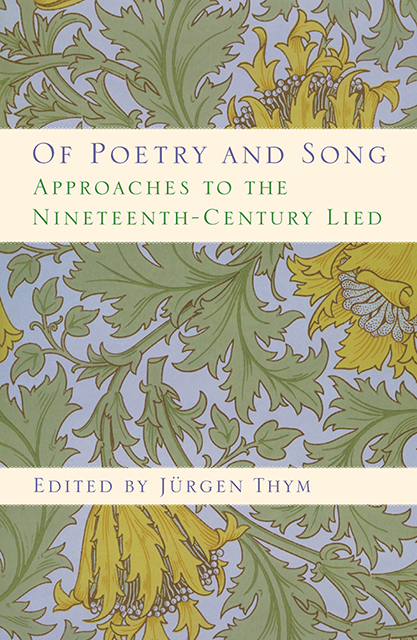Chapter Nine - Sonnet Structure and the German Lied: Shackles or Spurs?
Published online by Cambridge University Press: 02 March 2023
Summary
When scholars look at the relation of poetry to music in a song, they tend to concentrate on ideas and images and to examine how these are expressed or enacted by the setting. Less frequently do they ask whether and how it matters that poetry is set, not just vivid prose. Indeed, one might question whether poetic form really does matter or whether the delicate rhythms and patterns of a poem are simply overpowered by the more robust forces that shape a musical composition. This study explores these questions by looking at a poetic form—the sonnet— that is itself highly shaped, but not in a manner obviously and immediately compatible with the musical idiom of the nineteenth-century Lied.
In the poetry available to Lied composers the sonnet plays a vigorous and visible role, although it does not enjoy the same centrality in German verse as in English or Italian. Virtually absent in German eighteenth-century poetry, it was introduced with a flourish near the end of that century by Gottfried August Bürger and then by August Wilhelm von Schlegel, whose Petrarch translations were widely read. Stimulated by Schlegel and by the sonnets of Zacharias Werner, Goethe also turned to the form. Although his distaste for what he saw as “cut-and-paste” poetry is widely quoted, he quickly saw the relation of the sonnet to his belief that art reaches its highest freedom when it moves within constraints. Following these beginnings, the form was taken up by many of the finest German poets, including Platen, Eichendorff, Heine, Mörike, and many others. The great majority of these sonnets were written in the Petrarchan mold, with two quatrains followed by two tercets.
Even though they relied heavily on poetry favoring strophic organization, quatrains, simple rhyme structure, and tetrameter and trimeter verse, nineteenth-century Lied composers by no means avoided more complicated poetic forms and meters. In fact, the genre is marked by a central and important paradox. In literature, the term traditionally evokes short, strophic, and singable (or sung) poetry free of elevated diction and primarily concerned with nature, love, and everyday life.
- Type
- Chapter
- Information
- Of Poetry and SongApproaches to the Nineteenth-Century Lied, pp. 240 - 260Publisher: Boydell & BrewerPrint publication year: 2010



